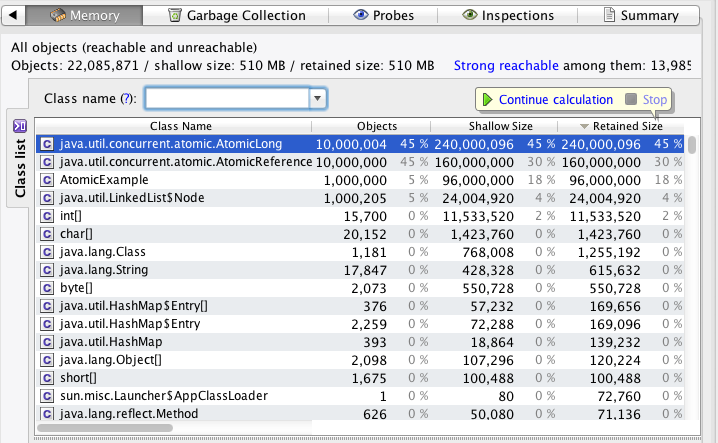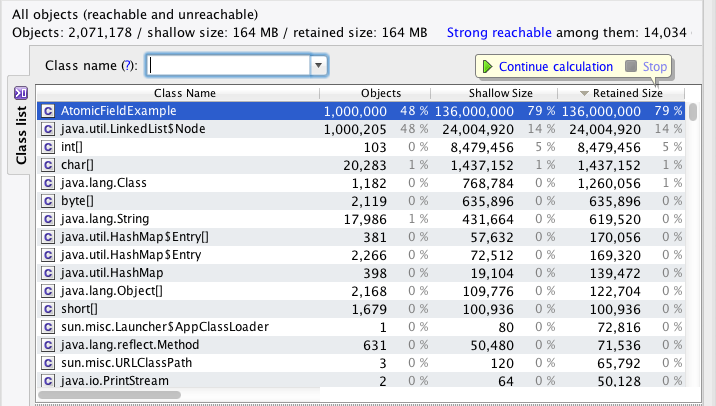Lesser known concurrent classes - Atomic*FieldUpdater
Today I want to talk about one of the lesser known utility classes when it comes to atomic operations in Java. Everyone who ever has done some real work with the java.util.concurrent package should be aware of the Atomic* classes in there which helps you to do atomic operations on references, Longs, Integers, Booleans and more.
The classes in question are all located in the java.util.concurrent.atomic package. Like:
AtomicBooleanAtomicIntegerAtomicReferenceAtomicLong- ….
Using those is as easy as doing something like: <pre class="syntax java"> AtomicLong atomic = new AtomicLong(0); atomic.compareAndSet(0, 1); … … </pre>
So what is the big deal with them? It's about memory usage …
Wouldn't it be nice to be able to just use a volatile long, save a object allocation and as a result use less memory?
HELL YEAH!
This is exactly where the not widely known Atomic*FieldUpdater comes in. Those allow you to do "atomic" operations on a volatile field and so save the space which is needed to hold the object that you would create if you would use something like AtomicLong. This works as Atomic*FieldUpdater is used as a static field and so not need to create a new Object everytime.
Neat, isn't it ?
So to replace the above usage of AtomicLong your code would look like:
private static final AtomicLongFieldUpdater<TheDeclaringClass> ATOMIC_UPDATER =
AtomicLongFieldUpdater.newUpdater(TheDeclaringClass.class, "atomic");
private volatile long atomic;
public void yourMethod() {
ATOMIC_UPDATER.compareAndSet(this, 0, 1);
...
...
}
This works with some reflection magic which is used when you create the AtomicLongFieldUpdater instance. The field names passed in as argument (in this case atomic) will be used to lookup the declared volatile field. Thus you must be sure it matches.
And this is one of the weak things when using Atomic*FieldUpdater as there is no way for the compiler to detect that those match. So you need to keep an eye on this by yourself.
You may ask you self about if it worth it at all? As always it depends… If you only create a few thousands instances of the class that use Atomic* it may not worth it at all. But there may be situations where you need to create millions of them and keep the alive for a long time. In those situations it can have a big impact.
In the case of the Netty Project we used AtomicLong and AtomicReference in our Channel, DefaultChannelPipeline and DefaultChannelHandlerContext classes. A new instance of Channel and ChannelPipeline is created for each new connection that is accepted or established and it is not unusal to have 10 (or more ) DefaultChannelHandlerContext objects per DefaultChannelPipeline. For Non-Blocking Servers it is not unusal to handle a large amout of concurrent connections, which in our case was creating many instances of the mentioned classes. Those stayed alive for a long time as connections may be long-living. One of our users was testing 1M+ concurrent connections and saw a large amount of the heap space taken up because of the AtomicLong and AtomicReference instances we were using. By replacing those with AtomicField*Updater we were able to save about 500 MB of memory which, in combination with other changes, reduced the memory footprint by 3 GB.
For more details on the specific enhancements please have a look at those two issues: #920 and #995
On thing to note is that there is no AtomicBooleanFieldUpdater that you could use to replace a AtomicBoolean. This is not a problem, just use AtomicIntegerFieldUpdater with value 0 as false and 1 as true. Problem solved ;)
Gimme some numbers
Now with some theory behind us, let's proof our claim. Let us do a simple test here: we create a Class which will contain 10 AtomicLong and 10 AtomicReference instances and instantiate itself 1M times. This resembles the pattern we saw within Netty.
Let us first have a look at the actual code:
public class AtomicExample {
final AtomicLong atomic1 = new AtomicLong(0);
final AtomicLong atomic2 = new AtomicLong(0);
final AtomicLong atomic3 = new AtomicLong(0);
final AtomicLong atomic4 = new AtomicLong(0);
final AtomicLong atomic5 = new AtomicLong(0);
final AtomicLong atomic6 = new AtomicLong(0);
final AtomicLong atomic7 = new AtomicLong(0);
final AtomicLong atomic8 = new AtomicLong(0);
final AtomicLong atomic9 = new AtomicLong(0);
final AtomicLong atomic10 = new AtomicLong(0);
final AtomicReference atomic11 = new AtomicReference<String>("String");
final AtomicReference atomic12 = new AtomicReference<String>("String");
final AtomicReference atomic13 = new AtomicReference<String>("String");
final AtomicReference atomic14 = new AtomicReference<String>("String");
final AtomicReference atomic15 = new AtomicReference<String>("String");
final AtomicReference atomic16 = new AtomicReference<String>("String");
final AtomicReference atomic17 = new AtomicReference<String>("String");
final AtomicReference atomic18 = new AtomicReference<String>("String");
final AtomicReference atomic19 = new AtomicReference<String>("String");
final AtomicReference atomic20 = new AtomicReference<String>("String");
public static void main(String[] args) throws Exception {
List<AtomicExample> list = new LinkedList<AtomicExample>();
for (int i = 0; i < 1000000; i++) {
list.add(new AtomicExample());
}
System.out.println("Created instances 1000000");
System.in.read();
}
}
You may think this is not very often the case in real world applications but just think about it for a bit. It may not be in one class but actually may be in many classes but which are still related. Like all of them are created for each new connection.
Now let us have a look at how much memory is retained by them. For this I used YourKit but any other tool which can inspect heap-dumps should just work fine.

As you can see AtomicLong and AtomicReference instances took about about 400 MB of memory where AtomicExample itself takes up 96MB. This makes up a a sum of ca. 500 MB memory that is used by each AtomicExample instance that is created.
Now let's do a second version of this class but replace AtomicLong with volatile long and AtomicLongFieldUpdater. Beside this we also replace AtomicReference with volatile String and AtomicReferenceFieldUpdater.
The code looks like this now:
public class AtomicFieldExample {
volatile long atomic1 = 0;
volatile long atomic2 = 0;
volatile long atomic3 = 0;
volatile long atomic4 = 0;
volatile long atomic5 = 0;
volatile long atomic6 = 0;
volatile long atomic7 = 0;
volatile long atomic8 = 0;
volatile long atomic9 = 0;
volatile long atomic10 = 0;
volatile String atomic11 = "String";
volatile String atomic12 = "String";
volatile String atomic13 = "String";
volatile String atomic14 = "String";
volatile String atomic15 = "String";
volatile String atomic16 = "String";
volatile String atomic17 = "String";
volatile String atomic18 = "String";
volatile String atomic19 = "String";
volatile String atomic20 = "String";
static final AtomicLongFieldUpdater<AtomicFieldExample> ATOMIC1_UPDATER =
AtomicLongFieldUpdater.newUpdater(AtomicFieldExample.class, "atomic1");
static final AtomicLongFieldUpdater<AtomicFieldExample> ATOMIC2_UPDATER =
AtomicLongFieldUpdater.newUpdater(AtomicFieldExample.class, "atomic2");
static final AtomicLongFieldUpdater<AtomicFieldExample> ATOMIC3_UPDATER =
AtomicLongFieldUpdater.newUpdater(AtomicFieldExample.class, "atomic3");
static final AtomicLongFieldUpdater<AtomicFieldExample> ATOMIC4_UPDATER =
AtomicLongFieldUpdater.newUpdater(AtomicFieldExample.class, "atomic4");
static final AtomicLongFieldUpdater<<AtomicFieldExample> ATOMIC5_UPDATER =
AtomicLongFieldUpdater.newUpdater(AtomicFieldExample.class, "atomic5");
static final AtomicLongFieldUpdater<AtomicFieldExample> ATOMIC6_UPDATER =
AtomicLongFieldUpdater.newUpdater(AtomicFieldExample.class, "atomic6");
static final AtomicLongFieldUpdater<AtomicFieldExample> ATOMIC7_UPDATER =
AtomicLongFieldUpdater.newUpdater(AtomicFieldExample.class, "atomic7");
static final AtomicLongFieldUpdater<AtomicFieldExample> ATOMIC8_UPDATER =
AtomicLongFieldUpdater.newUpdater(AtomicFieldExample.class, "atomic8");
static final AtomicLongFieldUpdater<AtomicFieldExample> ATOMIC9_UPDATER =
AtomicLongFieldUpdater.newUpdater(AtomicFieldExample.class, "atomic9");
static final AtomicLongFieldUpdater<AtomicFieldExample> ATOMIC10_UPDATER =
AtomicLongFieldUpdater.newUpdater(AtomicFieldExample.class, "atomic10");
static final AtomicReferenceFieldUpdater<AtomicFieldExample, String> ATOMIC11_UPDATER =
AtomicReferenceFieldUpdater.newUpdater(AtomicFieldExample.class, String.class, "atomic11");
static final AtomicReferenceFieldUpdater<AtomicFieldExample, String>ATOMIC12_UPDATER =
AtomicReferenceFieldUpdater.newUpdater(AtomicFieldExample.class, String.class, "atomic12");
static final AtomicReferenceFieldUpdater<AtomicFieldExample, String> ATOMIC13_UPDATER =
AtomicReferenceFieldUpdater.newUpdater(AtomicFieldExample.class, String.class, "atomic13");
static final AtomicReferenceFieldUpdater<AtomicFieldExample, String> ATOMIC14_UPDATER =
AtomicReferenceFieldUpdater.newUpdater(AtomicFieldExample.class, String.class, "atomic14");
static final AtomicReferenceFieldUpdater<AtomicFieldExample, String> ATOMIC15_UPDATER =
AtomicReferenceFieldUpdater.newUpdater(AtomicFieldExample.class, String.class, "atomic15");
static final AtomicReferenceFieldUpdater<AtomicFieldExample, String> ATOMIC16_UPDATER =
AtomicReferenceFieldUpdater.newUpdater(AtomicFieldExample.class, String.class, "atomic16");
static final AtomicReferenceFieldUpdater<AtomicFieldExample, String>ATOMIC17_UPDATER =
AtomicReferenceFieldUpdater.newUpdater(AtomicFieldExample.class, String.class, "atomic17");
static final AtomicReferenceFieldUpdater<AtomicFieldExample, String> ATOMIC18_UPDATER =
AtomicReferenceFieldUpdater.newUpdater(AtomicFieldExample.class, String.class, "atomic18");
static final AtomicReferenceFieldUpdater<AtomicFieldExample, String> ATOMIC19_UPDATER =
AtomicReferenceFieldUpdater.newUpdater(AtomicFieldExample.class, String.class, "atomic19");
static final AtomicReferenceFieldUpdater<<AtomicFieldExample, String>ATOMIC20_UPDATER =
AtomicReferenceFieldUpdater.newUpdater(AtomicFieldExample.class, String.class, "atomic20");
public static void main(String[] args) throws Exception {
List<AtomicFieldExample> list = new LinkedList<<AtomicFieldExample>();
for (int i = 0; i < 1000000; i++) {
list.add(new AtomicFieldExample());
}
System.out.println("Created instances 1000000");
System.in.read();
}
}
As you see the code becomes a bit more bloated, hopefully it pays out. Again let us take a look at the memory usage as before.

As you can see from the screenshot the memory footprint is a lot smaller. In fact it now needs not more then ca. 136MB of memory for the 1M instances of AtomicFieldExample. This is a nice improvement compared to the baseline memory footprint. Now think about how much memory you can save if you have a few cases where you can replace Atomic* classes with volatile and Atomic*FieldUpdater in classes that are instanced a lot.
You may ask yourself why the AtomicFieldExample is larger then the AtomicExample. This is caused by the extra memory you need to store the references + longs.
AtomicFieldExample has 10 longs + 10 references. This gives us:
- 10 * 8 bytes (for the longs)
- 10 * 4 bytes (for the references)
- 1 * 16 bytes (for itself)
AtomicExample has 20 refernces. This gives us:
- 20 * 4 bytes (for the references)
- 1 * 16 bytes (for itself)
So it only pays off because we save the extra memory overhead of AtomicLong and AtomicReference itself. So to put it straight: Every Object has a fixed overhead.
Beside the memory savings there are some other nice effect here, we did not mention before:
- Because we save Objects the Garbage Collector has less overhead to care about, as it needs to keep track of every Object.
- We save the tax of the built in monitor which comes as part of each Object
Summary
To summarize it, it may pay off to replace Atomic* objects with the corresponding volatile + Atomic*FieldUpdater. How much you save in terms of memory varies depending on what you replace. But the savings can be huge, especially when we talk about small "Objects".
Let us do the maths again:
AtomicLong= 24 bytes + 4 bytes (for the reference to it)volatile long= 8 bytes
This gives us a saving of 16 bytes!
Acknowledgements
Special thanks go out to Nitsan Wakart, Michael Nitschinger and Benoît Sigoure for the review and feedback.



